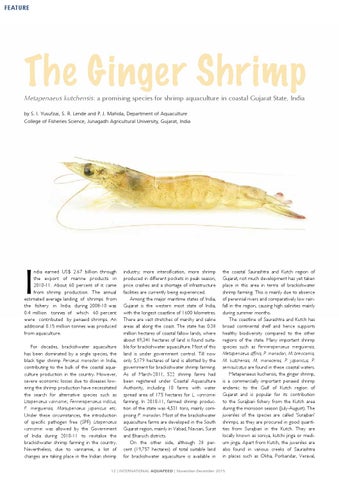FEATURE
The Ginger Shrimp Metapenaeus kutchensis: a promising species for shrimp aquaculture in coastal Gujarat State, India by S. I. Yusufzai, S. R. Lende and P. J. Mahida, Department of Aquaculture College of Fisheries Science, Junagadh Agricultural University, Gujarat, India
I
ndia earned US$ 2.67 billion through the export of marine products in 2010-11. About 60 percent of it came from shrimp production. The annual estimated average landing of shrimps from the fishery in India during 2008-10 was 0.4 million tonnes of which 60 percent were contributed by penaeid shrimps. An additional 0.15 million tonnes was produced from aquaculture. For decades, brackishwater aquaculture has been dominated by a single species, the black tiger shrimp Penaeus monodon in India, contributing to the bulk of the coastal aquaculture production in the country. However, severe economic losses due to diseases lowering the shrimp production have necessitated the search for alternative species such as Litopenaeus vannamei, Fenneropenaeus indicus, F. merguiensis, Marsupenaeus japonicus etc. Under these circumstances, the introduction of specific pathogen free (SPF) Litopenaeus vannamei was allowed by the Government of India during 2010-11 to revitalise the brackishwater shrimp farming in the country. Nevertheless, due to vannamei, a lot of changes are taking place in the Indian shrimp
industry; more intensification, more shrimp produced in different pockets in peak season, price crashes and a shortage of infrastructure facilities are currently being experienced. Among the major maritime states of India, Gujarat is the western most state of India, with the longest coastline of 1600 kilometres. There are vast stretches of marshy and saline areas all along the coast. The state has 0.38 million hectares of coastal fallow lands, where about 89,341 hectares of land is found suitable for brackishwater aquaculture. Most of this land is under government control. Till now only 5,179 hectares of land is allotted by the government for brackishwater shrimp farming. As of March-2011, 522 shrimp farms had been registered under Coastal Aquaculture Authority, including 10 farms with water spread area of 175 hectares for L. vannamei farming. In 2010-11, farmed shrimp production of the state was 4,531 tons, mainly comprising P. monodon. Most of the brackishwater aquaculture farms are developed in the South Gujarat region, mainly in Valsad, Navsari, Surat and Bharuch districts. On the other side, although 28 percent (19,757 hectares) of total suitable land for brackishwater aquaculture is available in
the coastal Saurashtra and Kutch region of Gujarat, not much development has yet taken place in this area in terms of brackishwater shrimp farming. This is mainly due to absence of perennial rivers and comparatively low rainfall in the region, causing high salinities mainly during summer months. The coastline of Saurashtra and Kutch has broad continental shelf and hence supports healthy biodiversity compared to the other regions of the state. Many important shrimp species such as Fenneropenaeus merguiensis, Metapenaeus affinis, P. monodon, M. brevicornis, M. kutchensis, M. monoceros, P. japonicus, P. semisulcatus are found in these coastal waters. Metapenaeus kuchensis, the ginger shrimp, is a commercially important penaeid shrimp endemic to the Gulf of Kutch region of Gujarat and is popular for its contribution to the Surajbari fishery from the Kutch area during the monsoon season (July-August). The juveniles of the species are called ‘Surajbari’ shrimps, as they are procured in good quantities from Surajbari in the Kutch. They are locally known as soniya, kutchi jinga or medium jinga. Apart from Kutch, the juveniles are also found in various creeks of Saurashtra in places such as Okha, Porbandar, Veraval,
12 | INTERNATIONAL AQUAFEED | November-December 2015
